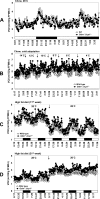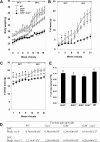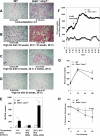Inactivation of UCP1 and the glycerol phosphate cycle synergistically increases energy expenditure to resist diet-induced obesity
- PMID: 18678870
- PMCID: PMC2562063
- DOI: 10.1074/jbc.M804268200
Inactivation of UCP1 and the glycerol phosphate cycle synergistically increases energy expenditure to resist diet-induced obesity
Abstract
Our current paradigm for obesity assumes that reduced thermogenic capacity increases susceptibility to obesity, whereas enhanced thermogenic capacity protects against obesity. Here we report that elimination of two major thermogenic pathways encoded by the mitochondrial uncoupling protein (Ucp1) and mitochondrial glycerol-3-phosphate dehydrogenase (Gdm) result in mice with increased resistance to diet-induced obesity when housed at 28 degrees C, provided prior adaptation occurred at 20 degrees C. Obesity resistant Gdm(-/-).Ucp1(-/-) mice maintained at 28 degrees C have increased energy expenditure, in part through conversion of white to brown adipocytes in inguinal fat. Increased oxygen consumption in inguinal fat cell suspensions and the up-regulation of genes of mitochondrial function and fat metabolism indicated increased thermogenic activity, despite the absence of UCP1, whereas liver and skeletal muscle showed no changes in gene expression. Additionally, comparisons of energy expenditure in UCP1-deficient and wild type mice fed an obesogenic diet indicates that UCP1-based brown fat-based thermogenesis plays no role in so-called diet-induced thermogenesis. Accordingly, a new paradigm for obesity emerges in which the inactivation of major thermogenic pathways force the induction of alternative pathways that increase metabolic inefficiency.
Figures





References
-
- Blundell, J., and Stubbs, J. (2004) in Handbook of Obesity (Bray, G., and Bouchard, C., eds) 2nd Ed., pp. 427-460, Marcel Dekker, Inc., New York
-
- Schutz, Y., and Jequier, E. (2004) in Handbook of Obesity (Bray, G., and Bouchard, C., eds) 2nd Ed., pp. 615-629, Marcel Dekker, Inc., New York
-
- Hill, J., Saris, W., and Levine, J. (2004) in Handbook of Obesity (Bray, G., and Bouchard, C., eds) 2nd Ed., pp. 631-653, Marcel Dekker, Inc., New York
-
- Lowell, B. B., and Spiegelman, B. M. (2000) Nature 404 652-660 - PubMed
-
- Schwartz, M. W., Woods, S. C., Seeley, R. J., Barsh, G. S., Baskin, D. G., and Leibel, R. L. (2003) Diabetes 52 232-238 - PubMed
Publication types
MeSH terms
Substances
Grants and funding
LinkOut - more resources
Full Text Sources
Medical
Molecular Biology Databases

